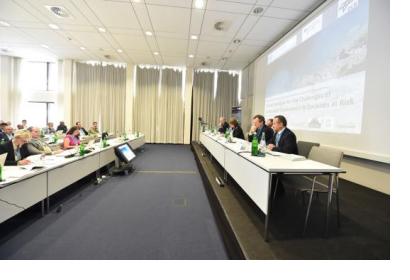On 28 May 2015, UNOOSA and its co-organizers, the German Aerospace Center (DLR) and the German Federal Ministry for Economic Affairs and Energy (BMWi), successfully concluded the three day United Nations/Germany International Conference on Earth observation in Bonn, Germany. The conference was kindly supported by Secure World Foundation, the City of Bonn and Digital Globe.
Under the theme of "Global Solutions for the Challenges of Sustainable Development in Societies at Risk", approximately 120 experts and participants from more than 35 countries in Africa, Asia, Europe, Latin America and the Caribbean convened in Bonn to discuss the benefits of Earth observation for sustainable development, including climate change and disaster risk reduction. Specifically, the participants discussed how Earth observation can feed into the Sendai Framework for Disaster Risk Reduction, the Sustainable Development Goals and the 2015 climate change agreement. The overall aim is to enable countries to better become aware and use Earth observation to reach the goals outlined in these three agreements.
In five plenary sessions, including discussing panels and presentations, and six working groups, the participants were able to hear about as well as discuss in detail novel technologies, global, regional and national efforts and examples of Earth observation. While the participants strongly agreed overall on the usefulness of Earth observation and derived products, work remains to be done in helping countries institutionalize these resources into their national plans and processes, such as monitoring of indicators. Cross-cutting challenges for all three frameworks (Sendai Framework for Disaster Risk Reduction, Paris Climate Change agreement and the Sustainable Development Goals) that were identified included the need to enhance collaboration between stakeholders, awareness raising among policy makers on the benefits of Earth observation, the access to space-based data and information and the need to harmonize capacity building efforts of different actors.
In her keynote speech, UNOOSA's director Simonetta Di Pippo stressed the importance of satellite data in sustainable development, climate change and disaster risk reduction. "This conference, beginning today, is a vital component in UNOOSA’s continuing work. The Conference is conducted as a way not only to contribute to the post-2015 development agenda, but also to bring together stakeholders to embark on joint efforts for facilitating the use of Earth observations for sustainable development."
The programme included a special talk by European Space Agency astronaut Alexander Gerst. He emphasized how the view from above can change one’s perception: “One of the most valuable things that we can find in space is a new perspective on our planet. This perspective is one of a small blue planet with limited resources, surrounded by a paper thin layer of air and with a highly fragile ecosystem. We get a special view on the only place known in our universe where humankind can live and on which everything is connected.”
The presentations of the conference as well as the technical report will be made available shortly on the conference page. See the agenda of the conference here. A selection of pictures is available on flickr. Read also the overview of the opening ceremony here.
In parallel to the conference, UN-SPACE conducted their 35th session on 27 May and organized a high-level panel on 28 May as part of the conference's programme tackling the question how the international community can promote the use of Space-based applications to address the post2015 Development Frameworks.
Additionally, the International Working Group on Satellite based Emergency Mapping (IWG-SEM) held its spring meeting on 28 and 29 May 2015 in Bonn back to back with the conference. At this occasion, UNOOSA took up the annually rotating position of official Chair of the group.

